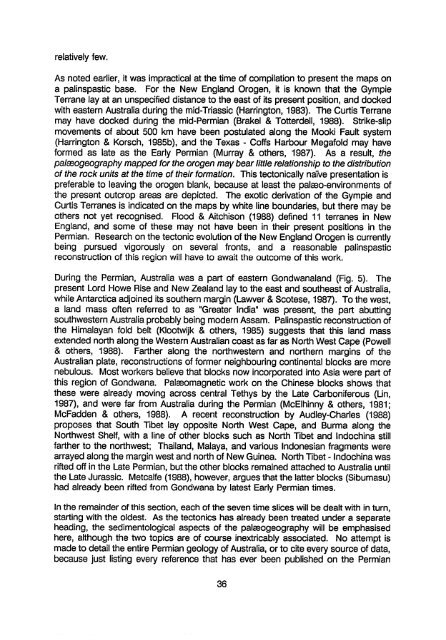II II II II II - Geoscience Australia
II II II II II - Geoscience Australia
II II II II II - Geoscience Australia
You also want an ePaper? Increase the reach of your titles
YUMPU automatically turns print PDFs into web optimized ePapers that Google loves.
elatively few.<br />
As noted earlier, it was impractical at the time of compilation to present the maps on<br />
a palinspastic base. For the New England Orogen, it is known that the Gynnpie<br />
Terrane lay at an unspecified distance to the east of its present position, and docked<br />
with eastern <strong>Australia</strong> during the mid-Triassic (Harrington, 1983). The Curtis Terrane<br />
may have docked during the mid-Permian (Brakel & Totterdell, 1988). Strike-slip<br />
movements of about 500 km have been postulated along the Mooki Fault system<br />
(Harrington & Korsch, 1985b), and the Texas - Gaffs Harbour Megafold may have<br />
formed as late as the Early Permian (Murray & others, 1987). As a result, the<br />
palmogeography mapped for the orogen may bear little relationship to the distribution<br />
of the rock units at the time of their formation. This tectonically naïve presentation is<br />
preferable to leaving the orogen blank, because at least the palmo-environments of<br />
the present outcrop areas are depicted. The exotic derivation of the Gympie and<br />
Curtis Terranes is indicated on the maps by white line boundaries, but there may be<br />
others not yet recognised. Flood & Aitchison (1988) defined 11 terranes in New<br />
England, and some of these may not have been in their present positions in the<br />
Permian. Research on the tectonic evolution of the New England Orogen is currently<br />
being pursued vigorously on several fronts, and a reasonable palinspastic<br />
reconstruction of this region will have to await the outcome of this work.<br />
During the Permian, <strong>Australia</strong> was a part of eastern Gondwanaland (Fig. 5). The<br />
present Lord Howe Rise and New Zealand lay to the east and southeast of <strong>Australia</strong>,<br />
while Antarctica adjoined its southern margin (Lawyer & Scotese, 1987). To the west,<br />
a land mass often referred to as "Greater India" was present, the part abutting<br />
southwestern <strong>Australia</strong> probably being modern Assam. Palinspastic reconstruction of<br />
the Himalayan fold belt (Klootwijk & others, 1985) suggests that this land mass<br />
extended north along the Western <strong>Australia</strong>n coast as far as North West Cape (Powell<br />
& others, 1988). Farther along the northwestern and northern margins of the<br />
<strong>Australia</strong>n plate, reconstructions of former neighbouring continental blocks are more<br />
nebulous. Most workers believe that blocks now incorporated into Asia were part of<br />
this region of Gondwana. Palmomagnetic work on the Chinese blocks shows that<br />
these were already moving across central Tethys by the Late Carboniferous (Lin,<br />
1987), and were far from <strong>Australia</strong> during the Permian (McElhinny & others, 1981;<br />
McFadden & others, 1988). A recent reconstruction by Audley-Charles (1988)<br />
proposes that South Tibet lay opposite North West Cape, and Burma along the<br />
Northwest Shelf, with a line of other blocks such as North Tibet and Indochina still<br />
farther to the northwest; Thailand, Malaya, and various Indonesian fragments were<br />
arrayed along the margin west and north of New Guinea. North Tibet - Indochina was<br />
rifted off in the Late Permian, but the other blocks remained attached to <strong>Australia</strong> until<br />
the Late Jurassic. Metcalfe (1988), however, argues that the latter blocks (Sibumasu)<br />
had already been rifted from Gondwana by latest Early Permian times.<br />
In the remainder of this section, each of the seven time slices will be dealt with in turn,<br />
starting with the oldest. As the tectonics has already been treated under a separate<br />
heading, the sedinnentological aspects of the palmogeography will be emphasised<br />
here, although the two topics are of course inextricably associated. No attempt is<br />
made to detail the entire Permian geology of <strong>Australia</strong>, or to cite every source of data,<br />
because just listing every reference that has ever been published on the Permian<br />
36

















